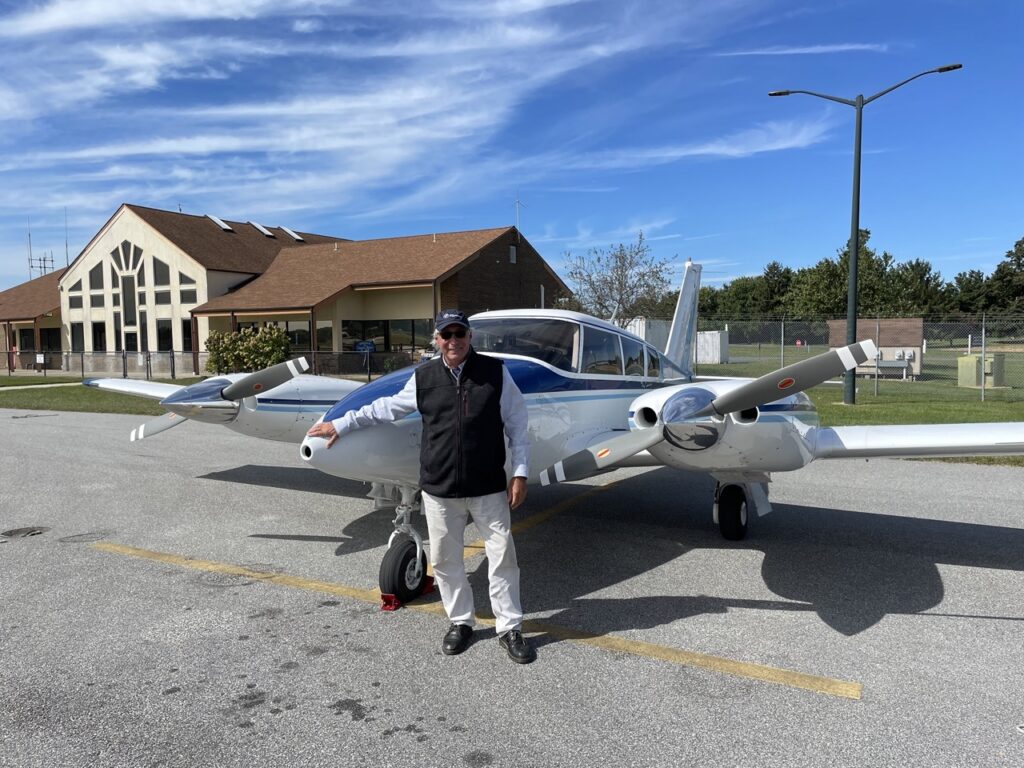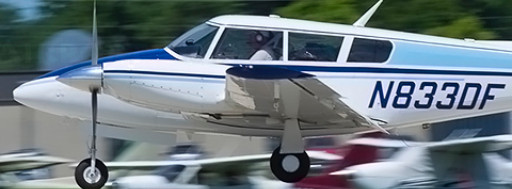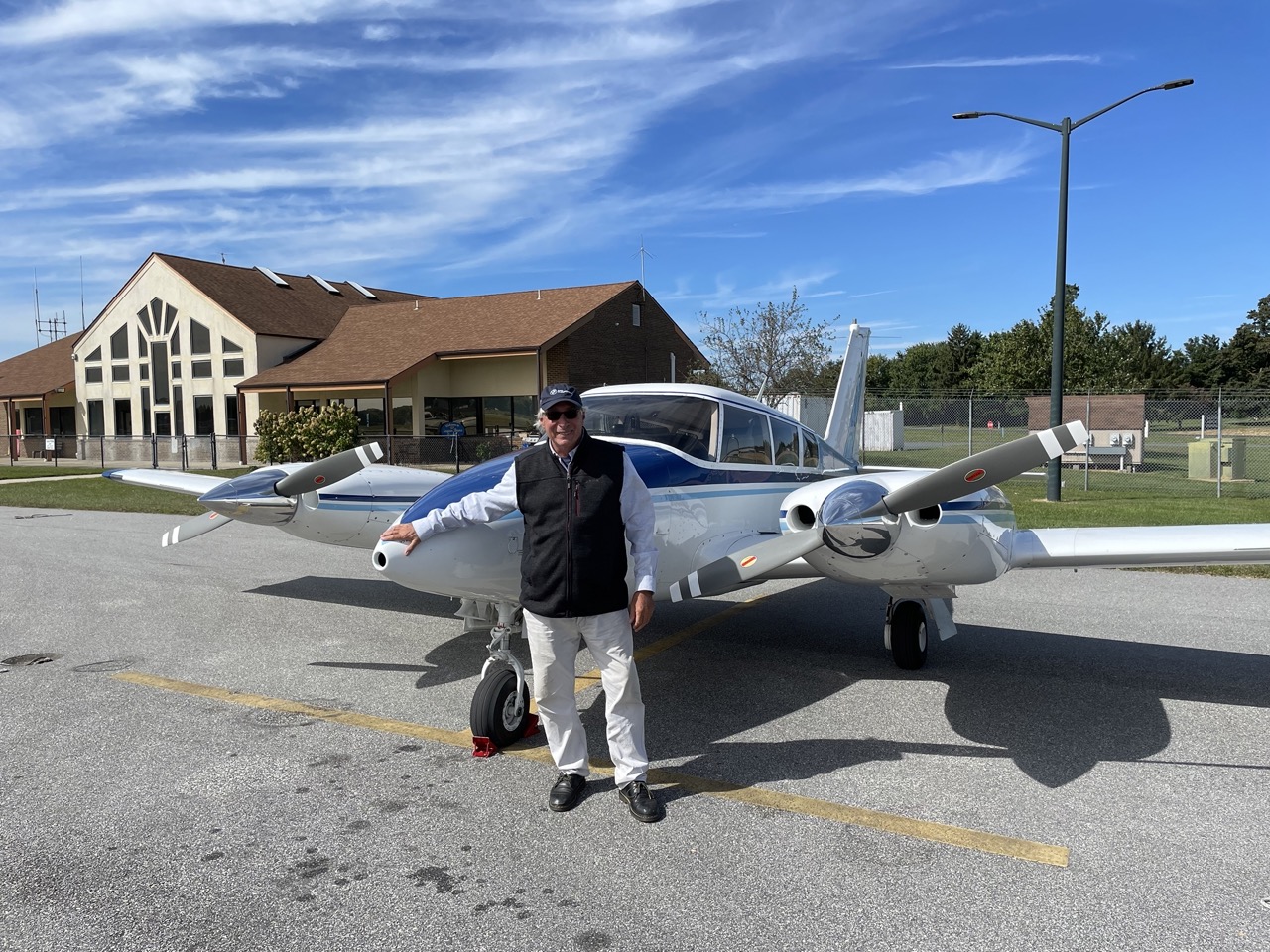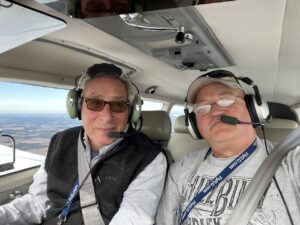I really wasn’t flying much in September, other than on a few solo practice flights I did to exercise the oil and prepare for an upcoming Flight Review I’ve been wanting to do. As I was prepping the airplane for one such mission, I ran into Kevin at the airport. I had promised Kevin a flight on the PA30, and the stars happened to align on September 29th. I still owe Mr William Smith a nice flight, and I’ll make an effort to align the stars again.

Kevin and I departed Wilmington and decided to do some local flying that included a stop at Easton for lunch. As it turns out, the restaurant there was closed and we fell back on an alternative plan. I think we had decided on Lancaster, but as you’ll soon see, it really didn’t matter. We wouldn’t be getting lunch today, after all.
We decided on a flight to Easton Airport (KESN) in Easton, MD. There is a restaurant there, Sugar Buns, that has good food, and is consistent. I briefed Kevin on the airplane, included the unique baggage door which serves as an alternate exit. I brief everyone on how to escape, and have them exercise the two step latch. I also brief them on where to step, and warn them to not touch the door getting into nor out of the airplane. The door is not designed to support weight, and I have it perfectly aligned at the moment.
The flight down to Easton was uneventful, and I enjoyed having Kevin along. I believe I handed over the controls for awhile, but I can’t recall if we got to that or not. I did the landing and we taxied up to the restaurant ramp.
We shut down and secured the airplane. Once again I briefed on the shutdown procedure, and advised Kevin not to move the props, nor even touch them for safety – just in case a ground wire had broken that day. I pointed out and verified that all the switches were in their proper position, and we exited the airplane.
Only when we approached the restaurant did we realize that it was closed. The website and the hours on the door indicated that was not right, but there was no one there to accept my complaints. I suggested Lancaster Airport for an alternate lunch stop, and we mounted up the airplane once again.
Hot starts can always be interesting. The Electro-Air systems I installed did make it better, as did the firewall forward upgrade I’d done some 300 hours ago. This time the hot start on both sides went according to plan, and I’m beginning to feel that I’m getting better at it.
Calling ground, they had us taxi on Alpha to runway 04 for our VFR departure north. I did my abbreviated run-up, since it was not the first flight of the day. For the abbreviated version, I do not normally do a full set of prop exercises, and today was no exception. The mag check was good on both sides, and the before takeoff checklist was completed. Cleared onto runway 04 for departure, we lined up on the centerline.
Mixtures and Props both forward. Both power levers (throttles in this case) full forward. My eyes naturally go right to the power indicating gauges, and my first call is generally ‘POWER SET’. I call this out after scanning both engine RPMs, MP gauges, and fuel flows, and seeing that all it well. It’s a quick scan as they are all on the same group of instruments and in the same place.
On this takeoff, I never made that call. The left engine RPM indication was showing several hundred RPMs lower than the right, when they both should be showing near red line (governor limited). I’ve seen this before, to a lesser degree, when the left prop was slightly slower to react or when I simply didn’t have one of the prop controls fully forward. I gave it a few more seconds and didn’t react right away. I divided my attention to staying on the centerline and giving the RPMs on the left an opportunity to retract this indignation!
Another few seconds passed before I announced ‘N833DF rejecting takeoff – Runway 04’. The tower controller didn’t understand what I was saying, so I repeated the same words as I’d been trained to do in the jets. When repeating it didn’t get the point across, I slowed down and said ‘we have an issue and are not taking off, I’ll exit the runway when able.’.
We rolled for a bit more because I still had not gotten the power levers all the way to idle. I think my brain was still thinking ‘WTF!’. We rolled slowly down the runway until my brain caught up with the airplane and crawled back inside.
Still, I was pleased with myself in detecting the issue before we gained much speed, and bringing the airplane safely back to taxi speed. I discussed the issue with Kevin, and we decided to taxi back to the pre-takeoff position for runway 04.
Alas, a self-clearing issue this was not. It became clear that we’d lost all control over the left engine propeller, so we weren’t going anywhere. With that, ground control guided me back to Trident Maintenance to see if they could help me.
I was pleased with Kevin. He was not a nervous passenger at all, but rather an effective crew mate. He was right there with me the entire time. We did crew briefings the entire flight, and as you’ll see, he decided to come along on the test flight as well. It was nice having effective crew onboard.
I have nothing but great stories when it comes to getting stuck away from home. I have broken down a number of times of 20 years and two airplanes, and not once did I not come home amazed at the help that materialized. I’ve never once seen anything but fair; over and above treatment by the mechanics I’ve encountered. Today would be no exception.
At Trident, there was one supervisor/manager there, one lead mechanic, and one other mechanic watching us taxi in. We shut down on their ramp, surprising them, but they were willing to help right out of the gate. I told them what happened and we all agreed that I’d probably need parts. That meant it’d most likely be days or weeks to get going again. They’d look at it nonetheless, and most importantly, promised to look after the airplane until the issue was resolved. I could not ask for anything more.
First things first – I called my wife to see if she could pick us up (2 hour drive each way). Beverly is a trooper, understood, and dropped what she was doing to come get me. I know she looks at her hassle free recovery as a means to help me in making the right go/no-go decision on any flight. That type of support is important. With that taken care of, the mechanics told me they’d take a quick look, and then secure the airplane for me. Then they sent us to a comfortable pilot lounge to wait (2 hours) for our ride home.
The next call I made was to Paul Phillips (Phill-Air). He is my airplane’s maintenance guy and is always willing to take my calls. Paul and I discussed what was going on. I explained that I was NOT looking for him to fix anything, nor make the problem go away. I just wanted to keep him in the loop, and use him as a resource as the issue further defined itself. Paul agree to stay involved in my decision making on these maintenance issues.
Good News! After ruminating about the turn of events with Kevin in the Pilot’s Lounge, the supervisor walked in to announce that the airplane was fixed and we were good to go!!! What?!?! Less than 15 minutes had passed!
Before I did anything, I caught Beverly just a few minutes from our house and turned her around. I let her know what I’d been told, and she immediately understood that it may change again. I’d need to do extensive run-ups and preflights before I agreed that all was well, so she promised to remain available. She’d be there if I needed her, and then she reminded me to make good decisions on safety of flight. Yup! I will.
So what happened? As it was explained to me, Lycoming equipped airplanes will have this problem occasionally where the weights in the prop governor get stuck. Simply tapping on them with a brass hammer will sometimes shake them loose, and that might be all you need to do. The mechanic happened to have just completed Lycoming school where they talked about this. He did what he’d been taught, and assured me I’m good to go.
I was speechless and very appreciative. Here I was expecting a wild hunt for parts in our current economic environment. Many hours of labor, and weeks or months without my airplane. Now I’m told I can fly it home and the only cost to me was an hour of labor. Freaking awesome!
The Test Flight: Kevin had heard the same explanation I did, and had all of the same information I had. While still in the Pilot Lounge, I gave him the choice to stay on the ground while I did a few test laps. I’d land and pick him up before flying home. He thought about it and felt comfortable coming along instead.
I paid the tiny tab and we mounted up once again. After an extensive pre-flight and run-up along runway 04 once again, including the full protocol as in the first flight of the day, we lined up for takeoff. The props both came up together, and the takeoff was normal. We remained in the pattern for two laps, exercising the props through a range of RPMs. Kevin and I were both comfortable after that, and we flew north to Wilmington.
I cheated Kevin out of lunch, which we had to skip due to the additional maintenance time we spent down there. The good news is that we had a positive aviation experience. Since this incident, I’ve put an additional 30 event free hours on the airplane in all kinds of weather. I think we are good.
Once again I’d like to thank all of the A&Ps who touch my airplane in it’s travels. I could not live this dream safely without you.
Fly Safe! Trust your A&P
Frank


